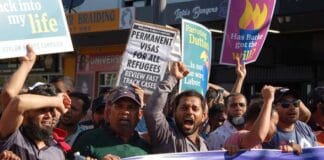For a week or two in mid-November, it seemed Australia’s detention regime was coming apart at the seams. In the aftermath of the second asylum seeker’s suicide in two months, anger and despair swept the detention centres, and dramatic protests erupted at Villawood and Christmas Island.
The suicide on November 16 of Ahmed al Abaki, a 41-year-old Iraqi with a wife and four children still in Iraq, sparked a hunger strike and angry protests the following afternoon. Five asylum seekers again took their protest to the rooftop of Villawood detention centre.
On Christmas Island the news of Ahmad’s death saw a vigil turn into a hunger strike involving up to 200 asylum seekers, while up to 20 people stitched their lips together. They were scenes reminiscent of the worst days of desperation under the Howard government and produced widespread calls for an end to mandatory detention.
The protests lifted the lid on the scale of self-harm and attempted suicide inside the detention centres. Immigration department reports show rates of detention self-harm are outstripping the rates under former Liberal Immigration Ministers Ruddock and Vanstone.
Even though the High Court decision seemed to offer a glimmer of hope to some, the numbers of people attempting self-harm seemed out of control. Ahmad was one of the asylum seekers affected by the High Court decision. But he had already spent a year in detention unable to support his family, and with the prospect of months more before any possible answer for him, the High Court decision was too little and too late.
The toll inside these “factories of mental illness” is growing. Three people attempted suicide at Curtin, and another attempted to hang himself on Christmas Island the same week as Ahmad’s suicide. In the same week, in Perth, two Tamils attempted suicide.
Meanwhile on the two consecutive days after Ahmad’s death, two Villawood detainees were hospitalised as their physical condition deteriorated from 16 days and 12 days respectively on hunger strike.
While each incident of self-harm or hunger strike protest has its own specific reasons, the underlying cause is easy to see—being ground down by months and months of arbitrary detention and uncertainty.
The protests in Curtin and Christmas Island come after another wave of asylum seekers received their first rejections. For Hazara Afghan asylum seekers in Curtin, after already enduring six months with their visa applications frozen, the uncertainty of months more in detention pushed people over the edge. The Tamils in Perth have been 18 months in detention waiting for a security clearance, with no guarantee it is coming any time soon or that it will be successful.
One of the hunger striking Tamils in Villawood, found to be a refugee, was waiting almost 18 months for a security clearance only to be told ASIO had found him to be a security threat. He now faces indefinite detention with no legal avenues to force ASIO to disclose the basis of their finding or to challenge it.
Ending mandatory detention
The horror of lip stitching, shockingly emblematic of the abuses under Howard’s detention regime, stunned veterans of the refugee campaign.
Amnesty International had already called for an end to mandatory detention and the closure of Christmas Island after touring Christmas Island, Curtin and Darwin detention centres in early October. It has now sent a report about detention conditions to the United Nations highlighting conditions in Darwin for children and families. It says that almost all the women in the ASTI Motel accommodation are on anti-depressants.
Amnesty is also scathing about the Labor government’s children out of detention announcement—reinforcing the argument that groups like the Refugee Action Coalition have been making.
Strong comments too have come from the Human Rights Commissioner, Catherine Branson, who has called for legislative changes to the Migration Act to keep children out of detention.
She said about 850 children were currently in immigration detention and they should all be included in the government’s plan to house children in the community by June next year. The government will only commit to extending this plan to “some”.
Opinion on refugees is polarising. To counter the right, the refugee movement will have to fight Gillard even harder. There is a substantial fight ahead. But, the grassroots campaign has shifted public opinion and Labor policy before, under the Howard government. The crisis in detention and Gillard’s Howard-esque response is creating an important minority that isn’t willing to settle for anything less than closing Christmas Island, and putting an end to offshore processing, and mandatory detention, once and for all.
By Ian Rintoul





